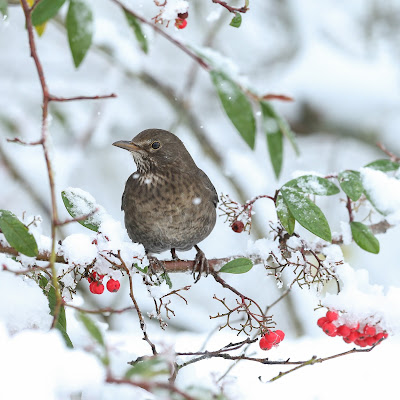 |
| Redwing (c) JR |
Winter
arrived this weekend with a vengeance. Saturday was frosty, crisp, clear and
sunny, whilst early on Sunday morning it started to snow and then continued all
day. It meant that I only managed to get down to the moor on Saturday.
 |
| All over the first screen (c) Bark |
I
remember the last serious snowfall about seven years ago. On that occasion,
determined to get down there, I set out in the morning for Otmoor, parked in
Beckley and walked down the lane. We luckily got a lift in a 4x4 back up to the
village but then I managed to get my car stuck in Barton as I tried to get up
the hill and back into Oxford. Having learned my lesson on that occasion on
Sunday I let discretion be the better part of valour and stayed home.
Saturday
morning was beautiful on Otmoor. The air was totally fresh, clean and gin
clear. The low sun emphasised the last of autumn’s colours, especially the
golds and ochres of the reedbed.
 |
| Gold of the reedbed (c) Bark |
There was a fringe of ice at the first screen,
but the regular ducks dabbled or dozed on the muddy margins. Careful scrutiny
revealed Snipe, perfectly camouflaged and almost totally hidden in the reeds. Two
juvenile Marsh Harriers alternated between perching at the top of the low
willows in the northern reedbed and cruising above the reeds causing surprised
Teal to flush briefly, but appearing to offer the Teal no real threat.
 |
| Reflective ducks (c) Bark |
Just as last
week, the feeders and the regular feeding spots beside the hide were a real
magnet to birds. The game strips adjacent to the woods and the Closes also held
large numbers of finches. We walked up the footpath to the east of Sling copse
on yet another fruitless search for Hawfinches, reported last week from
Charlton on Otmoor and from Horton cum Studley. Sadly, neither location close
enough to count towards the Otmoor basin year list!
 |
| Linnets (c) Early Birder and Goldfinch (c) Bark |
The walk however did mean
that we found at least two Bramblings feeding with a mixed party of finches on
one of the tracks that headed away from the footpath and towards Lower Farm.
This happened as we were on our way back towards the carpark to head home and
we were running short of time. On another occasion it would be worthwhile
spending longer checking through these birds as they might well have attracted
other scarcer species to the flock.
 |
| Seasonal Thrushes (c) JR |
I am hopeful
that this cold snap will be temporary as the wildlife does suffer hugely in
these extreme conditions. In the last cold snap, we lost all our resident
Cetti’s Warblers and saw no Stonechats for well over a year. If the reedbed
freezes solid the Starling roost will collapse, as there is little security in
roosting on a reed stem if predators can walk out and grab you from below. Also
in the event of a big freeze wildfowl will move to larger deeper waterbodies or
to the coast.
As I have
been writing this I have heard that six winter swans have flown over Otmoor
Reserve and from their calls have been identified as Bewick’s. This is very
pleasing as the species have not been recorded on the moor for several years. Worryingly
they are becoming much rarer than they once were. They later landed at Pit 60
where they were filmed (see Oxon Bird Log) looking exceptionally beautiful.
I look
forward to a gentle thaw and more water building up across the reserve as we
move towards the year’s end.
 |
| Car Park Kestrel (c) Early Birder |































